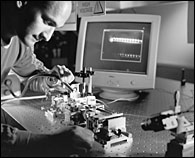All photonics, all the time
The speed of communications is getting faster and faster, and increased bandwidth is allowing for more information to be sent from one end of the earth to the other. If technological visionary David Plant has his way, networks will soon be zipping along data at the speed of light over vast distance.
 McGill's Photonic Systems Laboratory
McGill's Photonic Systems LaboratoryPHOTO: Jasmin Provost |
|
Today, McGill and its partners are launching a five-year Agile All-Photonic Networks (AAPN) research project, made possible by a whopping $7 million grant awarded by the Natural Sciences and Engineering Research Council of Canada (NSERC).
David Plant, James McGill Professor of Electrical and Computer Engineering, is the grant's principal investigator and AAPN scientific director. The multidisciplinary AAPN includes four other universities, three federal laboratories, and seven private Canadian companies. Together, they plan to explode the telecommunications capacity to previously unimaginable speed and ability.
Networks currently use a mix of photonic (light-based) and electronic technologies to carry data. Fibre optics are tremendously fast and efficient on their own, but the data transfer gets bogged down along the way at electronic switch points. These are where the light streams need to be converted to electrical signals to be processed and routed, then switched back again to photons before the message continues along its merry path.
Plant and the AAPN team will work to develop an all-photonic switch that would greatly speed up the signal rerouting time, and eliminate as many electronic switch points as possible. The less time wasted switching from photonics to electronics, and back again, the faster information will flow, and the consumption of power will be reduced. "We'll send more information in a seamless way and in a less expensive way," Plant says.
By pushing the electronic-to-photonic components as close to the user's end as possible, the user "will be closer to the lightwave technology, which is the really high bandwidth stuff," Plant says. He sees photonic transmission as nimble, a sort of rapid flicker that will allow multiple usage simultaneously.
Network users will be able to transmit information -- personal, medical, professional -- instantaneously. Imagine a world in which Montreal surgeons will be able to transmit images to colleagues around the world so they can jointly and immediately analyze a tumour. Or how easily a sign language translator in Boston can help a lawyer in Whitehorse with a deaf client. Already, top violin students in an audio lab at McGill are able to take master classes from maestro Pinchas Zukerman in Ottawa's National Arts Centre.
Plant explains that the AAPN research network also plans to design new architectures to take full advantage of an all-photonic switch, and research how light behaves on this new type of network.
The AAPN is the only research network devoted to this endeavour in Canada, and Plant knows he has the resources and researchers to be competitive with those in the States and Europe. "It's a very rich system problem and there are lots of possibilities for solutions," Plant says. "It's the Holy Grail. Lots of people are attempting to achieve this technological vision."
The Canada Foundation for Innovation gave $35 million to AAPN members to beef up their already superbly equipped labs, but the group needed money to put working bodies in those labs. Plant took two years to write up the NSERC proposal, which provides funding over five years -- "a long time in the life of an academic," Plant says.
The grant includes funding for 35-40 graduate students at any one time, and 15-20 undergraduates in the summers. "They're the ones doing the real work," Plant says of his graduate and postdoctorate students. "They're the workforce, and the energy behind the project."
Thanks to the bursting of the tech bubble, Plant's graduate students aren't being poached by start-up companies anymore. Also, graduate student applications are even stronger, what with all that talent now out of work. And ex-students are donating expensive equipment to the university from their downsizing companies. Recently, Plant received a shipment of a half-million dollars' worth of lab tools.
"The tech boom produced a lot of 'noise,'" Plant says. "I got at least three calls a week from people asking me to join their start-ups, or to examine proposals, or to be a consultant. I don't miss it."
"The 'quiet' is a good thing. [The companies'] diminishing resources mean we're more important. Universities are back to doing what they do best, which is to focus on long-term research."
For more information see www.aapn.mcgill.ca. There are 12 professors from five universities involved. Five of the professors are from McGill, and Plant is the grant's principal investigator. McGill's professors involved in the project are: Andrew Kirk, Mark Coates, Richard Vickers and Lawrence Chen. Queen's, McMaster, and the Universities of Ottawa and Toronto are participants.

